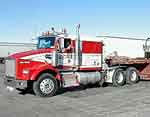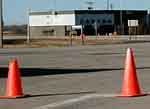By Dan Gunderson
Minnesota Public Radio
December 17, 2001
|
| RealAudio |
The Sept. 11 terrorist attacks raised U.S. border security to the highest level, "red alert." That means extra work for the people who monitor dozens of border crossings. It can also mean lost time and money for those who cross the border.
| |
|
|
|
||
The Pembina port is busiest of the more than 30 ports of entry along the Canadian border with Minnesota and North Dakota. About 800 trucks a day roll through this crossing. They carry some of the estimated $2 billion a day in U.S.-Canadian commerce. For the truckers, trade is flowing a bit slower these days.
Joe sits in his big rig at a Pembina truckstop. He's from Alberta. Joe has been waiting to cross the border for two days. He says the Customs agents no longer accepts a faxed copy of paperwork, so he's stuck here until the document is delivered by mail.
"I think about it differently, that it's going to consume more of my time to get across than it did before. But what can you do?" he says.
Joe doesn't think the tighter border security will hurt big businesses. But he says it is affecting his bank account.
"You're losing making those miles. You don't get to make the miles in the hour or two it takes to cross," Joe says. "You've lost two hours out of your day, so it's two hours later you've got to work to get to your destination."
Joe says he expects longer waits at the border are here to stay.
Customs officials say they're doing all they can to keep traffic flowing smoothly. Joan Sebanaler, assistant port director for trade in Pembina, says it's rare to have long lines at ports of entry. But Sebanaler says people should be prepared for a wait - and a bit more scrutiny.
"The difference between what we were doing before Sept. 11 and now is - we would randomly check for identification purposes. We would run identification, we would run license plates verifying to make sure everybody is who they say they are. (Now) it is no longer random. It is everyone," Sebanaler says.
That includes local residents who - for years - have crossed the border with a wave and a nod.
Pembina City Administrator Kathy Johnson says local residents on both sides of the border are a bit frustrated with the change.
| |
|
|
|
||
"We have friends that live in Emerson and come down here to go to church. One of the recent times they were asked for birth certificates for their children. And if you don't have that in your car, which most people don't, then it takes a lot longer," Johnson says.
The border is a big part of the reason Pembina exists. Kathy Johnson says at least one-third of the local economy is based on currency exchange brokers and travel-related businesses. And nearly everyone has a family member or friend working on the border.
"They are working double shifts, and working seven days a week, and not getting any time off," Johnson says. "You can do that for a certain length of time, but after awhile it really starts to wear on your body and your family relationships."
Customs officials say they don't know how long the northern border will stay on red alert.
There are 15 ports of entry in Minnesota and 19 in North Dakota. Many are on lightly-traveled roads. Before Sept. 11, many had customs inspectors only during the day. At night the ports were closed by putting orange traffic cones across the highway.
At a recent Congressional hearing, U.S. Sen. Byron Dorgan, N.D., used the orange cones as an example of gaping holes in border security.
"It can't walk, can't talk, can't shoot and can't tell a terrorist from a tow truck. And it just sits there at 10 o'clock at night at many locations," Dorgan said. "The polite people who come through illegally actually get out of the car and move it, and then put it back. Those who aren't so polite go through and shred that orange rubber cone."
Customs official Joan Sebanaler admits the orange cones only work for law abiding citizens. But she says with limited staff, it was the only option.
Sebanaler says the orange cones now have backup.
"The orange cones are still there, but they have a human with them. They have human company 24 hours a day. And that is why we've had to bring in inspectors from other locations," says Sebanaler.
| |
|
|
|
||
The Customs Service won't say how many inspectors have been added to the northern border, or where they are. The Border Patrol is similarly circumspect about security.
It is responsible for guarding the miles of prairie and forest between ports of entry. Dirt roads and farm fields provide endless opportunities to slip across the border.
The Border Patrol is no longer allowed to talk about its operations. But a couple of years ago, this agent talked about the frustration of patrolling the border. For security reasons, the Border Patrol does not want agents identified.
"It's an open border. And the people who are the illegal, illicit traffic that comes through here, they're working under the premise it is an open border. They're rarely if ever apprehended," said the agent.
The Border Patrol has added agents and increased electronic and aerial surveillance. Still, the northern border is nearly invisible. Often it's identified only by a narrow cut through the brush or a farmer's fence. Customs official Joan Sebanaler says the border is marked at intervals, but she's not sure where.
"I've been wandering around, and I don't think I'd ever done it if I hadn't been with my husband looking for a Christmas tree," Sebanaler says. "I saw the marker. That one was east of Lancaster some where. I don't know where they are. I have no knowledge of how many there are, where they are."
The remoteness of the northern border can be a security challenge. But it also makes illegal crossing more than a stroll in the park, especially in winter. Border Patrol agents have rescued many would-be interlopers from an icy death.
U.S. officials acknowledge it may be impossible to keep the longest open border in the world completely secure. U.S. Immigration and Naturalization Service Commissioner James Ziglar says the sheer volume of traffic poses a nearly overwhelming task. Billions of dollars and millions of people cross the border every year.
"When you look at the flow of the commerce and individuals, you get a little better idea of why controlling the borders is such a problem. Maybe it's not an impossibility, but it's a very big problem," says Ziglar.
And it's a problem U.S. Customs, Immigration and Border Patrol are likely to be wrestling with as long as terrorists are a threat to the United States.



